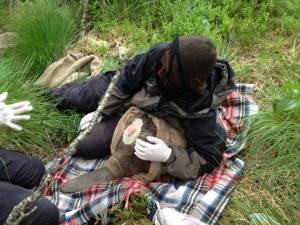So after months of being locked inside my bedroom revising (procrastinating) summer has finally begun and for me that means placements, placements, placements! What better way to start off the season than spending a month in Scotland working with the Scottish Beaver Trial!
Beavers back in Scotland!? I am sure most of you will have seen in recent media that beavers Castor fiber are in fact back in Scotland as part of a five year conservation project set up in 2009. They have been extinct from the area for about 400 years predominately due to hunting and this is the first reintroduction project of its kind in Britain, aiming to determine how beavers can enhance and restore natural environments. Referred to as ecological engineers and a keystone species, they modify the surrounding environment by coppicing, damming, and creating new wetland habitat, demonstrating their vital role in enhancing the environment, which is vital for many other species of flora and fauna (aquatic and terrestrial).
So with the car packed with as much as physically possible I embarked on the 10 hour journey North with Sophie, the longest journey her little car has ever faced. But we made it!
After a much needed early night, the placement kicked off. The trial site, located in Knapdale Forest, Argyll is 50 square km and home to four beaver families within four different lochs. The first task was to familiarise ourselves with the trial area and to collect camera traps that are regularly set up around these lochs to confirm the presence of beavers at close range, which is not easy due to their crepuscular lifestyle. It was fascinating to see the lodges and dams within each loch. In order to create the dam, sticks are positioned horizontally and the water then forces these into the substrate, creating an A frame. Beavers need the water level to be constant so they will make repairs/ alterations dependent on water level and weather. On returning to the office and after hours of analysing camera trap footage, we were able to identify individuals due to unique scars on their tails (beavers are extremely territorial) and ear tags. This was our best find of the day!
Night watches are also a vital method in confirming beaver presence and were completed from either a boat or a nearby bank. I was lucky enough to observe Millie the beaver chomp down a small tree who then proceeded to dive with large branches underwater to her lodge (the entrance is underwater to avoid predation). We witnessed bracken being consumed and taken into lodges and also got the fright of our lives when Frank tail slapped the water before diving (beavers can hold their breath for up to 15 minutes!) Unfortunately the worst thing about these night watches were the midges, but we did invest in some rather fetching head nets (which I am sure mine had a hole in!) and doused ourselves in midge spray (doesn’t work). All findings are then entered into an online database as well as into a Geographic Information System (ArcMap) so findings can be seen visually.
Every 6 months field sign surveys must also be conducted to determine if there are any dispersing individuals. Signs include feeding stations, tracks, dams, lodges and evidence of coppicing. Beavers also create small channels to enable efficient movement in the area, particularly when evading any perceived risks. As the trial is reaching its end (2014) these are becoming increasingly important, but during my time with the trial we did not find any signs of beaver presence. On-going water monitoring is also a vital component of the trial. Cryptosporidium and giardia are tested for monthly and are both associated with the faeces of most mammals species and can cause stomach upsets in humans if ingested. In general water quality has improved in all four lochs, however it is important to note that this is site specific. Water chemistry testing is also carried out in order to analyse the composition of the water.
Not every day can be spent outside enjoying the sunshine and beautiful views. Other duties included the checking and updating of social media pages and completing general office duties, which are vital in keeping the trial running smoothly. A considerable time was also dedicated to sifting through caecum contents of beavers hunted in Norway. As delightful as this sounds, it was actually quite interesting. Our task was to search for a host-specific fluke to contribute to the data of an on-going PHD study on whether or not the fluke negatively impacts the beaver and other associations.
On our last day we were lucky enough to tag one of the beavers whom we trapped overnight with a home-made GPS tag. Once mounted onto the beavers back, the tag records GPS locations as well as temperature and pressure. This also gives staff the opportunity to conduct a quick health check on an individual. The trial previously used radio telemetry to locate individuals; however this can be expensive and is not always the easiest option due to the canopy surrounding the lochs. Before the release I was allowed to feel Christians tail, which felt very snake like. In fact, when the church introduced an ‘eat fish every Friday’ rule beavers were eaten as they were once thought to be fish due their scaly tail! (click here to see a video of Christian’s release)
I thoroughly enjoyed my time with the Scottish Beaver Trial and could not recommend it enough if you are looking to enhance your C.V and develop your field work skills. As the trial is now reaching its end, final reports will be produced and the government will decide what the next steps will be for beavers in Scotland. I do hope full approval is given and that the current population can be supplemented in order to create a genetically diverse population.








Pingback: Devon Adventures – British Mammal Workshop | HOWL